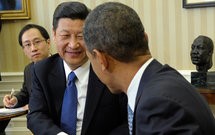 With the US stepping up effort towards its Asian rebalancing strategy, three fundamental elements must be understood: Are the US strategic lenses now shifting away from Europe to Asia? Is Asia the playground for the next Great Game? Is the Asian rebalance aimed at containing China?
With the US stepping up effort towards its Asian rebalancing strategy, three fundamental elements must be understood: Are the US strategic lenses now shifting away from Europe to Asia? Is Asia the playground for the next Great Game? Is the Asian rebalance aimed at containing China?
Firstly, the US focus is not shifting away from Europe and towards Asia; and neither is the US attention towards Asia a new phenomenon. It is important to bear in mind that Asia was never on the sidelines of US policy. The continent has always been important to the US. What is unfolding at the moment is the rise in the intensity of focus towards the region.
During the Cold War, Europe, given its geographical proximity to the then Soviet Union, enjoyed greater importance in the US policy-making circles, an example being the Marshall Plan for economic aid to the continent.
However, a variety of its associations with Asian nations, such as Washington’s alliance with Japan following the Second World War; its support of South Korea in the Korean War; its active backing of the Taiwanese cause; involvement in the Vietnam War; the attempt at rapprochement with China and their subsequent cooperation against the then Soviet Union in Afghanistan, among others, defined and reinforced Asia’s role as a playground for US activities. Subsequently, the disintegration of the Soviet Union rendered Europe as less strategically important, comparatively.
Secondly, post the Cold War, Asia’s significance in the US strategic calculus rose primarily as a result of four factors.
The US has consistently remained apprehensive of three looming potentially armed conflicts between Asia’s nuclear powers: India and Pakistan; India and China; and North Korea and South Korea. The US efforts in the region are towards achieving ‘deterrence stability’ to ensure that low intensity conflicts do not trigger nuclear war.
The concern over the security of nuclear weapons in India, Pakistan and North Korea has driven the US to actively monitor and engage with the region.
Post the Cold War, Asia has emerged as the productive motor of the global economy – be it Asian Tiger economies in the early 1990s or India and China over the last decade. Given the grim situation at home, the US views Asia’s economic potential as a means to revitalise its own economy. At present, this region performs the role of a foundation for a range of new institutional innovations. In the future, much of the competition for influence will be on access to membership in such institutions – complimenting the capitalist approach to decision-making in the US.
The vast reserves of natural resources in Asia’s oceans have also resulted in increasing maritime competition. Additionally, ensuring the security of sea lanes used for trade and other projects, especially with linkages to the Straits of Hormuz, Malacca and Sunda, has become a critical issue.
However, post 9/11, the US’ priorities in Asia got diverted. Not surprisingly, the ensuing ‘War on Terror’ assumed a greater precedence for the US. With this war slowly winding down now, Asia, as a region, has reassumed its primacy in US lenses. This rebalance thus stems from a terror and threat-centric perspective, and it is not dictated by the emergence of a ‘Great Game’ played out in an opportunity-rich Asia.
This does not spell the reduction in importance for regions outside Asia for the US. Given the geopolitical developments in the Arctic region, the energy-rich Persian Gulf, or the politically unstable Middle East in recent times, the US’ priorities will keep shifting rapidly.
Thirdly, the US is not fond of emerging regional hegemons, as it perceives them as a threat to its old alliances. Currently, it is undertaking efforts to refresh old alliances and forge new partnerships through preferential Free Trade Agreements under the umbrella of the Trans-Pacific Partnership.
The US has also realised the significance of a narrow military strategy, characterised by the shift of a marginal 3 per cent of its forces to the region. This is Washington’s attempt to prepare a response to Beijing’s strategy of Anti-Access/Area-Denial. Essentially, the rebalance is a symbolic announcement of the US’ intent to maintain force as an option for itself, while it simultaneously advices others against it.
Although the US government has publicly denounced the possibility of a containment strategy several times, it is important to note its recognition of the fact that its economic ties with China are too immense to engage in the conventional containment strategy that was adopted against the Soviet Union.
Ironically, growing economic ties, largely characterised by a negative balance of trade, has actually created complications for the US, unlike during the Cold War, where the confrontation with the Soviet Union could be blatantly aggressive and seen as a simple zero-sum game. Hence, rebalancing, for the US, is also about walking the tight rope between balancing relations with China as well as its own regional allies.
By Special Arrangement with Institute of Peace and Conflict Studies (http://www.ipcs.org)